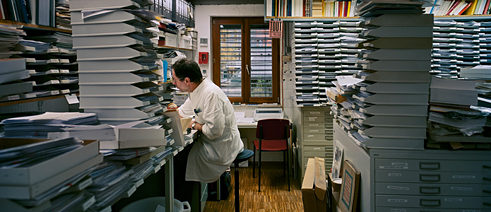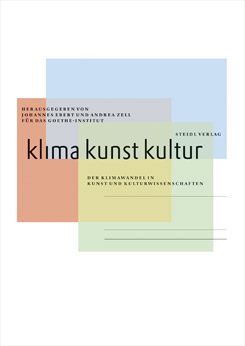An Interview with Gerhard Steidl
“A book needs to be a work of art”

Gerhard Steidl believes in the future of printed books. Now, the publisher of Günter Grass and Karl Lagerfeld manufactured a book with the Goethe-Institut that is one-hundred percent environmentally friendly. In our interview, Steidl explains how that is done and what books have in common with luxury watches.
Printing is a high-pollutant industry. Wouldn’t it be better for the environment to stop printing books and only distribute them over the Internet?
A printing or publishing house that doesn’t have the expertise to produce durable, beautiful books ought to stop and just put its works on the Internet. The quality of an analogue book has to justify it. Besides the authors or artists and editors, the graphic designers, typographers and image editors, printers and bookbinders have to do their best to lend a book the prerequisites for durability. Buying a physical book needs to be like buying a work of art that will still be in someone’s library 100 or 200 years hence. Like a luxury watch, we always buy a book for the next generation. I can download reading material for my next holiday from the Internet, though; it needn’t be printed.
The volume “Klima, Kunst, Kultur” was produced according to ecological principles. What exactly does that mean?
About 15 years ago, the Öko-Institut in Darmstadt documented all of our industrial processes: where chemicals, where natural and where artificial raw materials are used, energy consumption, etc. In the end, they handed us guidelines for environmentally optimizing our production. Since then I have often consulted with experts to improve things further. Just one example: while we used about 2,000 litres of isopropyl alcohol 15 years ago – isopropyl is a carcinogenic and destroys the ozone layer – we now use none at all.
And, now, when the Goethe-Institut came to you about publishing “Klima, Kunst, Kultur”...
...I immediately had the vision that we ought to at the same time give readers an idea of how a book can be well manufactured from an environmental point of view. It is, essentially, printed in the book. Of course, a designer, graphic artist, photographer, publisher or printer has to acquire additional knowledge. The end result is sustainably designed production.
Can you see or smell that when you hold the book in your hands?
 Klima Kunst Kultur. Der Klimawandel in Kunst und Kulturwissenschaften. Edited by Andrea Zell and Johannes Ebert for the Goethe-Institut, 168 pages, 32 EUR
| Copyright: Steidl
Yes, of course. It begins with the book jacket printed on uncoated paper. Plastic sheets are usually used for the surface finish to make it scratch resistant. In this case, it’s a special coating that feels like plastic, but in fact is based on natural waxes. Then it goes on to the cover, which is unbleached and looks like burlap. We use natural glue, the endpapers are one hundred percent cotton and dyed using plant fibres.
Klima Kunst Kultur. Der Klimawandel in Kunst und Kulturwissenschaften. Edited by Andrea Zell and Johannes Ebert for the Goethe-Institut, 168 pages, 32 EUR
| Copyright: Steidl
Yes, of course. It begins with the book jacket printed on uncoated paper. Plastic sheets are usually used for the surface finish to make it scratch resistant. In this case, it’s a special coating that feels like plastic, but in fact is based on natural waxes. Then it goes on to the cover, which is unbleached and looks like burlap. We use natural glue, the endpapers are one hundred percent cotton and dyed using plant fibres.
What about the paper inside?
It’s a speciality from the United States, one hundred percent recycled paper, but which is only recognizable as such in the tiny fibre elements. White and printed waste paper is separated in the mill and the paper mill also bleaches the paper itself. The result is a sensational paper for which not a single tree was felled.
How about the use of water?
This paper mill, like most paper manufacturers in Europe, uses a closed water cycle. Of course, a little fresh water must be added because water evaporates during the production process. But no wastewater is discharged. A lot has been done and changed in the printing industry. Klima, Kunst, Kultur is an example of all of it.
You say that the art of making books is at an historical pinnacle that can probably never be reached again.
The market won’t grow any more. More and more information that was once printed is moving to the Internet, consequently it’s no longer worthwhile for printing press and ink manufacturers or paper mills to invest in new products. Worldwide there is only one single paper machine manufacturer: Voith in Germany. They haven’t had an order for new machines for 14 years; they only survive on repair work. Even if someone would order a paper machine now, it would take seven years for it to be set up and commissioned. That alone shows that something is dying out. Well, fortunately we will be able to produce good paper on today’s paper machines for another 100 years. But there’s no more growth. It’s the same situation with printing presses, dyes and inks, the production of linen and endpapers: it is all at a technical pinnacle. But there’s a lack of incentives for further development. In one hundred years people in industrial production will only dream of being able to print the way we do today.
Have you noticed rising demand for exceptional, beautifully made books?
Yes, I notice it at our publishing house. Ten years ago, the price threshold for visual books was certainly 50 euros, today it doesn’t matter if a book costs 100 or 120 euros, people buy them. Other publishing houses are experiencing the same thing. Gestalten in Berlin, for example, decided to only produce clothbound hardcover books. They say they’d rather make them a little more expensive and deliver the highest quality. They are making a profit with that while other publishing houses that produce cheap, cheap, cheap, are consistently losing market shares.
When was the tipping point reached?
About five years ago. I also made the decision back then to stop producing paperbacks. Almost our entire output is clothbound or covered in handmade papers. Many publishing houses are making this decision in order to survive: offer better quality and then carefully raise the prices. And the buyers who really want physical books accept that.
What international markets are particularly appealing?
Asia for instance, because book production as we know it in Europe is practically non-existent. Although there are many publishing houses in South Korea everything is printed in Hong Kong or in China and the printing culture has been lost. It’s died out. But there are many young people who are learning to print and aim to make a livelihood with it in their countries. It’s similar in the United States: you can have a thread-stitched book printed there, but the binding has to be made in Canada because there is not a single bookbindery in the States that does thread stitching.
And how do things look in Central Europe?
Germany, Austria, Switzerland, France, Italy, Spain, Poland, Hungary are the virtual gold mines for the printing industry; that’s where most of the know-how is concentrated. The governments in these countries really should be funding their graphic industries and considering them export goods. One thing that the Goethe-Institut could undertake is to recruit graphic artists, designers, typographers, printers and bookbinders in other countries, offer seminars with them for young people so that someone in India, Angola or South America learns how high quality books are made. I hope for such a mission.
A personal question: You work from early in the morning until late at night; when do you have the time to read books?
Certainly not during the week. But I do read quite a lot, mainly poetry, preferably over the weekend. I sit down with a poem, read it three or four times, first to myself, then out loud. I really enjoy that. That’s how I conquer a book of poetry over a few days. I save epic works for the holidays. And I don’t like reading while travelling because I always fall right to sleep in planes, trains or cars.